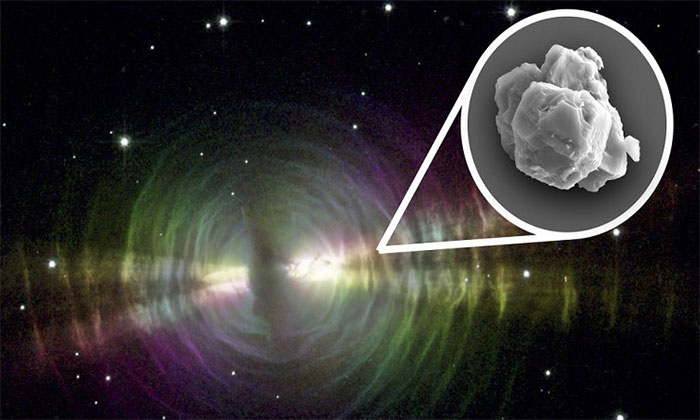The 7 billion-year-old star dust in asteroid hits Earth
Scientists identified the giant rock meteorite that fell to Earth half a century ago containing dust and is believed to be the oldest solid material.
Ancient stellar dust includes particles that existed before the Sun and fired into the universe from dead stars in the final stages of their life cycle. Part of the stellar dust was brought to Earth by the asteroid creating Murchison meteorite , a 100 kg stone weighing on September 28, 1969 near the town of Murchison, Victoria, Australia.

Star dust samples came before the solar system.(Photo: Live Science).
New analysis on 40 dust particles from the Murchison meteorite revealed they have a diverse date. 60% of particles date from 4.6 to 4.9 billion years, about 10% at least over 5.6 billion years. The age is determined at the time the stars explode. Based on the fact that this type of star has a lifespan of 2 to 2.5 billion years, the team estimates that stellar dust is about 7 billion years old, 2.5 billion years earlier than the Solar System.
Despite the abundance of stellar dust in the universe, researchers have never found stellar dust larger than the Sun in rock samples on Earth. That's due to the tectonic plates, volcanic eruptions and other planetary processes that heat and transform all ancient star dust, according to lead researcher Philipp Heck, director of meteorite research. and polar region at Field Natural History Museum in Chicago.
When large meteors formed like asteroids creating Murchison meteorite, they enveloped the ancient stellar dust particles. But unlike the continually moving planets, the meteorite is an inert mass from the nebula and kept it from that, preventing star dust from melting into another form of mineral, Heck explained.
Most stellar dust is about 1 micron or smaller. But the dust particles the team analyzed were much larger, between 2 and 30 microns long. " We call them 'pebbles'. We can observe them with an optical microscope," Heck said.
In the study, Heck and colleagues examined 40 " pebbles" from the Murchison meteorite. They crushed pieces of meteorite, then small acids help dissolve minerals and silicate. The researchers use dating technology based on the exposure of dust particles to cosmic rays in the interstellar journey that takes billions of years.
In space, high-energy particles emanate from various sources, colliding and piercing solid objects flying through. By measuring the amount of different elements in the dust particle, the team can estimate the time it is exposed to cosmic rays.
- A stir of microorganisms living in the comet dust cling to ISS
- Wild comet dust 2 reveals the surprising things of the solar system
- Stunned to discover the secret Itokawa asteroid
- Video simulating the meteorite scene hit the globe
- The mission to bring 4.5-year asteroid specimens back to Earth
- Close up of asteroid dust through a microscope, revealing many mysteries
- The biggest asteroid in the year is rushing towards Earth
- The asteroid is about to fly closest to Earth in 115 years
- Discovered 'assassin planets' in outer space
- Dust-producing asteroids can combat climate change on Earth
- The billion-dollar asteroid is about to fly across the earth
- The giant galaxy is 12.5 billion light-years from Earth
- 4.6 billion year old cosmic dust covered the roof of Europe
- Discover many interesting things in the star closest to the solar system
 Van Allen's belt and evidence that the Apollo 11 mission to the Moon was myth
Van Allen's belt and evidence that the Apollo 11 mission to the Moon was myth The levels of civilization in the universe (Kardashev scale)
The levels of civilization in the universe (Kardashev scale) Today Mars, the sun and the Earth are aligned
Today Mars, the sun and the Earth are aligned The Amazon owner announced a secret plan to build a space base for thousands of people
The Amazon owner announced a secret plan to build a space base for thousands of people